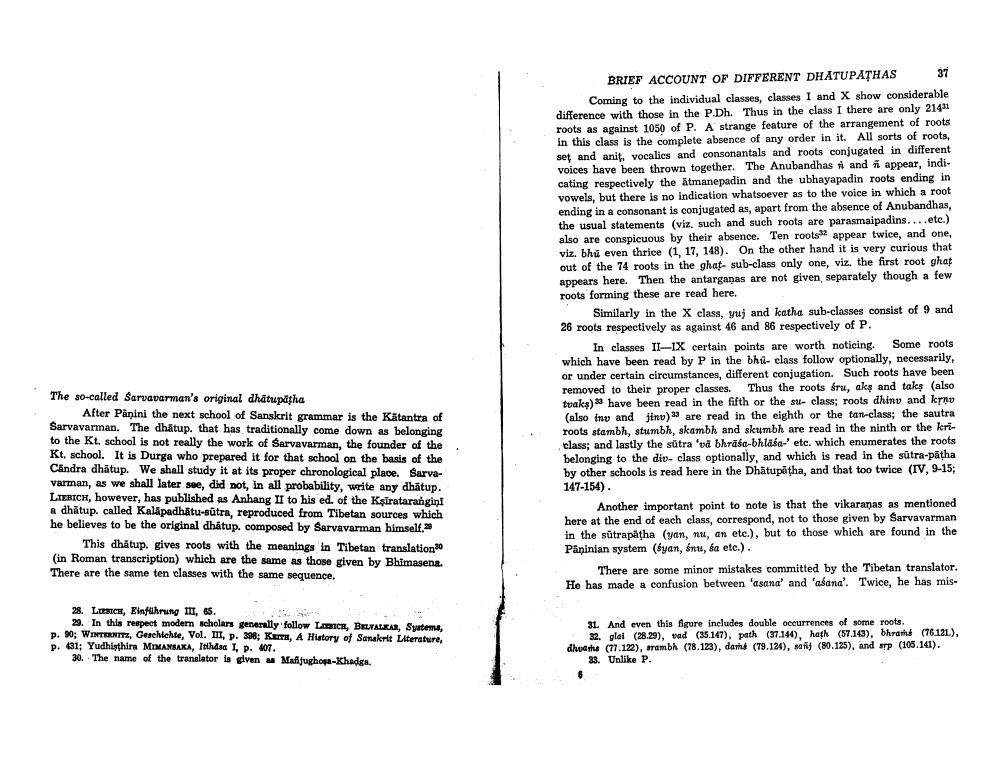Book Title: Brief Account Of Different Dhatupatras Author(s): G B Palsule Publisher: G B Palsule View full book textPage 1
________________ BRIEF ACCOUNT OF DIFFERENT DHATUPAȚHAS 37 Coming to the individual classes, classes I and X show considerable difference with those in the P.Dh. Thus in the class I there are only 21431 roots as against 1050 of P. A strange feature of the arrangement of roots in this class is the complete absence of any order in it. All sorts of roots, set and anit, vocalics and consonantals and roots conjugated in different voices have been thrown together. The Anubandhas and fi appear, indicating respectively the atmanepadin and the ubhayapadin roots ending in vowels, but there is no indication whatsoever as to the voice in which a root ending in a consonant is conjugated as, apart from the absence of Anubandhas, the usual statements (viz, such and such roots are parasmaipadins....etc.) also are conspicuous by their absence. Ten roots appear twice, and one, viz. bhe even thrice (1, 17, 148). On the other hand it is very curious that out of the 74 roots in the ghat- sub-class only one, viz. the first root ghat appears here. Then the antarganas are not given separately though a few roots forming these are read here. Similarly in the X class, yuj and katha sub-classes consist of 9 and 26 roots respectively as against 46 and 86 respectively of P. In classes II--IX certain points are worth noticing. Some roots which have been read by P in the bhu- class follow optionally, necessarily, or under certain circumstances, different conjugation. Such roots have been removed to their proper classes. Thus the roots éru, aks and tale (also tvaka) have been read in the fifth or the su- class; roots dhiny and lernu (also inv and invas are read in the eighth or the tan-class: the sautra roots stambh, stumbh, skambh and slumbh are read in the ninth or the lericlass; and lastly the sutra 'va bhrāsa-bhidea- etc. which enumerates the roots belonging to the div. class optionally, and which is read in the sutra-patha by other schools is read here in the Dhätupatha, and that too twice (IV, 9-15; The so-called Sarvavarman's original dhatupatha After Panini the next school of Sanskrit grammar is the Katantra of Sarvavarman. The dhatup. that has traditionally come down as belonging to the Kt. school is not really the work of Sarvavarman, the founder of the Kt, school. It is Durga who prepared it for that school on the basis of the Candra dhatup. We shall study it at its proper chronological place. Sarvavarman, as we shall later see, did not, in all probability, write any dhätup. LIEBICH, however, has published as Anhang II to his ed. of the Kşiratarangini a dhatup. called Kalapadhâtu-sútra, reproduced from Tibetan sources which he believes to be the original dhätup. composed by Sarvavarman himself. This dhätup. gives roots with the meanings in Tibetan translation 30 (in Roman transcription) which are the same as those given by Bhimasena. There are the same ten classes with the same sequence. 147-154). Another important point to note is that the vikaranas as mentioned here at the end of each class, correspond, not to those given by Sarvavarman in the sütrapàtha (yan, , an etc.), but to those which are found in the Paninian system (syan, na, ka etc.). There are some minor mistakes committed by the Tibetan translator. He has made a confusion between 'asana' and 'asana'. Twice, he has mis 28. LURICH, Einfahrung III, 6. 29. In this respect modern scholars generally follow LADIC, BELYALKAR, Systems, P. WO W INTERNITZ, Geschichte, Vol. II, p. 338; KEITH, A History of Sanskrit Literature, p. 431; Yudhisthira MIMANSAKA, Itthdaa I, p. 407. 30. The name of the translator is glven a Mafijughop-Khadga. 31. And even this figure includes double occurrences of some roots. 32. glai (28.29), vad (35.147), path (37.144), hath (57.143), bhrath (76.121.), dhuahua (17.122), arambh (78.123), dams (79.124), safty (80.125), and srp (105.141). 33. Unlike P.Page Navigation
1 2 3 4 5 6 7 8 9
